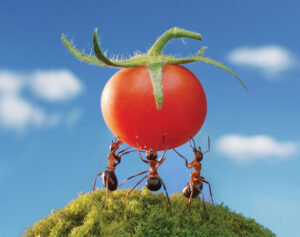 Insects are the way of life for gardeners. And they have an amazing way of gnawing on your garden produce the day before you think it’s ripe. Such is Illinois life.
Insects are the way of life for gardeners. And they have an amazing way of gnawing on your garden produce the day before you think it’s ripe. Such is Illinois life.
Of course, certain vegetables are insect magnets.
If you raise eggplant, you’re bound to get flea beetles, which create little round holes in the leaves, almost to the point of causing the leaf to yellow and fall off. That will reduce the eggplant yield.
Cucumbers attract cucumber beetles, which can lead to cucumber bacterial wilt. Beans are plagued by bean leaf beetles, especially in rural areas.
And, if you attempt to raise anything related to cabbages, such as collards, broccoli, cauliflower and kale, you’ll get all the loopers and cabbage worms. Of course, many insects are a good source of protein if you accidentally munch on one.
Sadly, if you look long and hard, and in some cases about a nanosecond in front of you, you can find something feeding on every vegetable. But many, such as tomato hornworms, aren’t that crucial in the grand scheme of things, with the plants being more resistant and tougher than the insects.
But when insects are plenty, and control is needed, the first thing you do is nothing. Stop. Think. What is the best and safest control?
In many cases, it isn’t chemicals. In fact, chemicals should be the last resort.
Of course, the ideal situation is to go back in the spring and determine if there are more insect-resistant cultivars of the fruits and vegetables you want to grow. There might be. There might not be. Still, always look to see if something is more resistant to any pest, or maybe plant at a different time to avoid damage. This happens with late-planted cucumbers and beans.
Make sure there is proper moisture, fertilization, and the soil is properly worked, and a healthy plant is able to tolerate more insect problems.
Next, are there things you can physically do? For example, if you see a tomato hornworm or cabbage looper, flick in on the ground and bring rapid decompression with your foot. In other words, squish the insect. (We tend to avoid the phrase “squash the bug” as the zucchinis get upset with profiling.)
If you don’t want to bring your foot down hard, use a stick to smash or poke the critter, or put it between two bricks with the same compression factor transferred to your hands. Sure, they’ll be some juicy bits, but remember it’s all organic and benefits the soil.

If the thought of killing the creature outright bothers you, knock it into a can with soapy water, or just a plain paper sack and dispose of the creature in the trash.
Streams of water will knock off the non-flying female aphids. Water can remove other creatures as well, but those with wings will just fly back up.
And when you have to resort to chemicals, go with the safer ones first. Insecticidal soaps and summer oils do a good job suffocating many insects without harming the plants.
When you do use chemicals, make sure to ALWAYS read and follow the directions on the label. If the insect you are trying to control, or the plant with the pest is NOT listed on the label, it is illegal to use that product.









